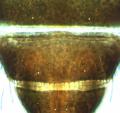Toxonothrips gramineae
Recognition data
Distinguishing features
Females fully winged. Body brown, tarsi and apices of tibiae yellow, also antennal segments III–IV and base of V; fore wings light brown with base paler. Head about as long as wide, broadly and roundly projecting in front of eyes; 2 pairs of ocellar setae present, pair III wide apart lateral to ocellar triangle; one pair of postocular setae displaced toward posterior. Antennae 7-segmented; segments III–IV with short forked sensorium. Pronotum with little sculpture and few discal setae; 2 pairs of long posteroangular setae. Metanotum irregularly reticulate; median setae small and arising behind anterior margin; campaniform sensilla present. Fore wing first vein with 2 setae on distal half; second vein with about 12 setae. Abdominal tergites V–VIII with paired ctenidia, on VIII posteromesad to spiracle; tergites V–VI with paired campaniform sensilla close to posterior margin; tergite VIII with complete comb of relatively widely separated slender teeth. Sternites without discal setae.
Related and similar species
Two species are described in Toxonothrips, the second being T. fuscus Post from Oregon. The genus is closely related to, and presumably derived from, the genus Thrips, but has the head prolonged in front of the eyes.
Taxonomic data
Current valid name
Toxonothrips gramineae Moulton
Original name and synonyms
- Toxonothrips gramineae Moulton, 1927: 30
Family placement
Thripidae, Thripinae
Biological data
Life history
Presumably breeding on leaves rather than in florets.
Host plants
Poaceae or Cyperaceae, but with no recorded specificity.
Tospoviruses vectored
None
Crop damage
None
Distribution data
Area of origin
Western USA
Distribution
California







